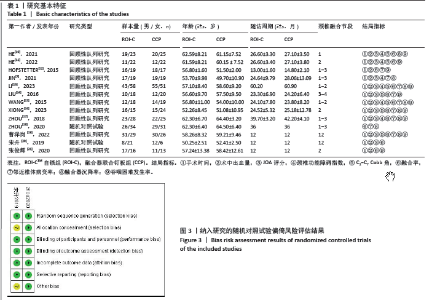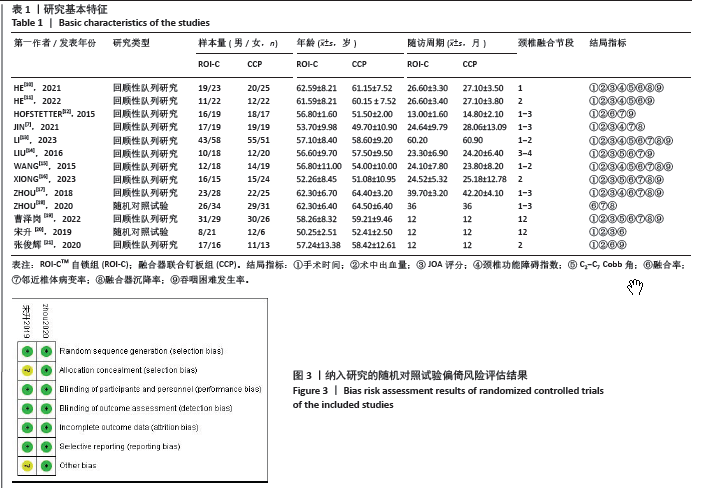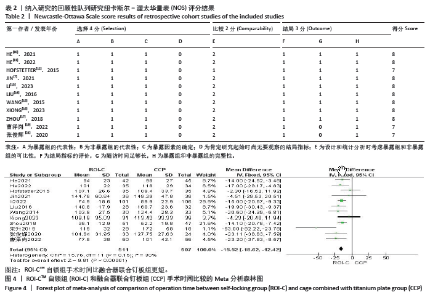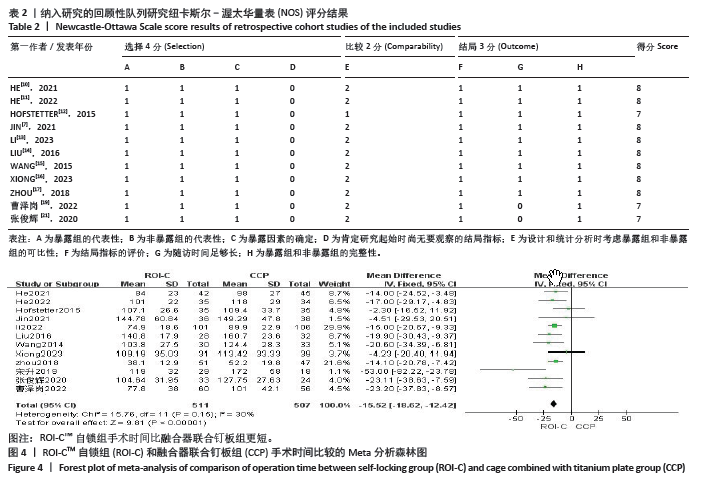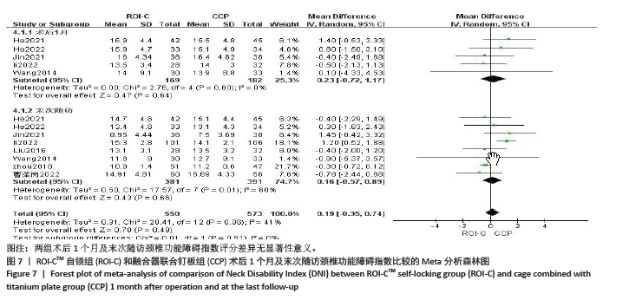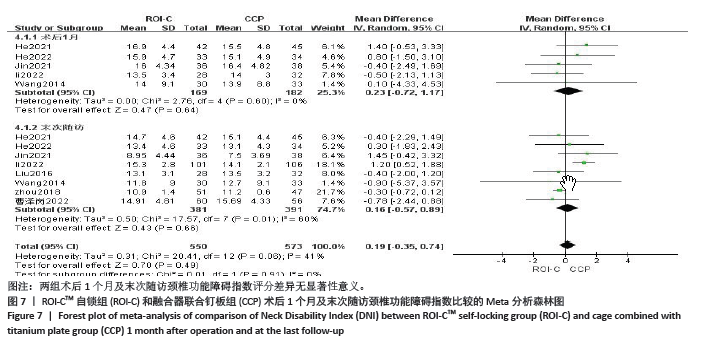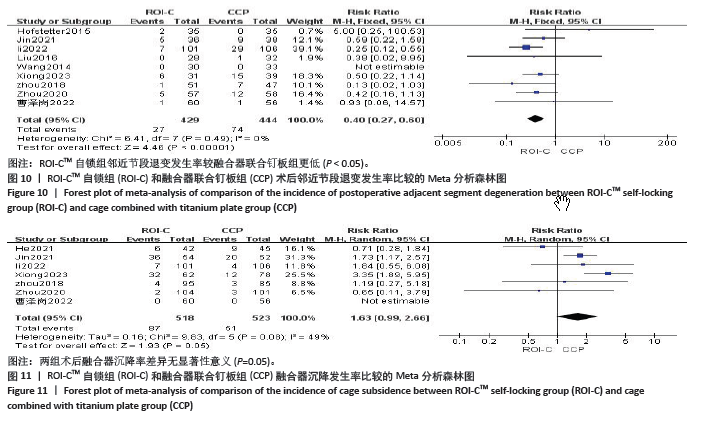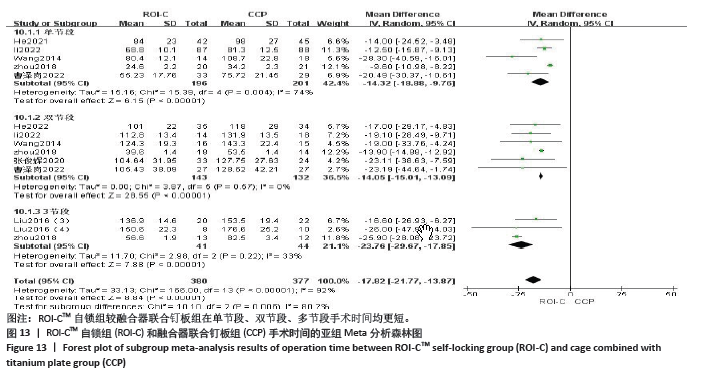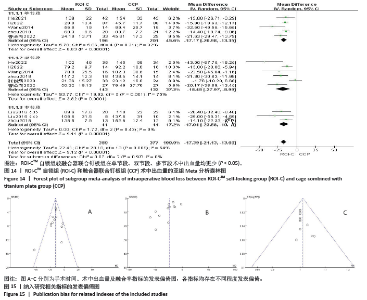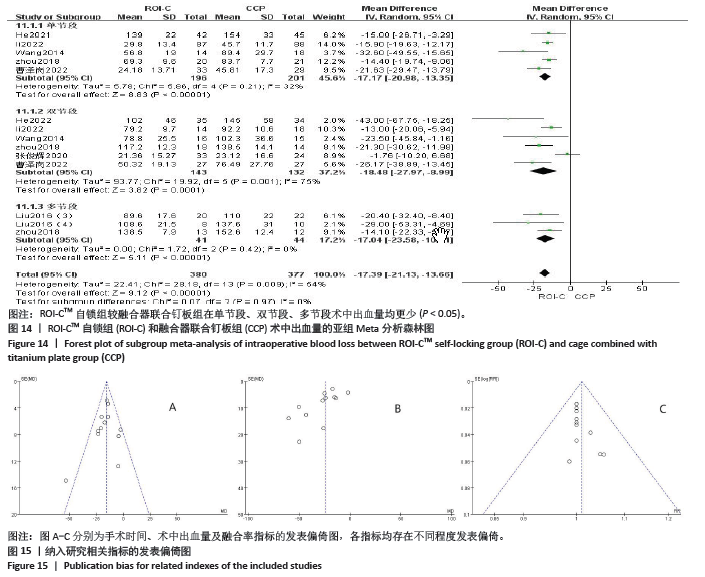Chinese Journal of Tissue Engineering Research ›› 2025, Vol. 29 ›› Issue (3): 617-627.doi: 10.12307/2025.114
Previous Articles Next Articles
Meta-analysis of anterior cervical decompression and fusion ROI-CTM self-locking system in treatment of degenerative cervical spondylosis
Zhou Yanjie, Cao Chunfeng, Zhang Zhongzu, Niu Xiong, Wang Xin, Yang Zaihai, Zhou Liang, Li Bo
- Yongchuan Hospital Affiliated to Chongqing Medical University, Chongqing 402160, China
-
Online:2025-01-28Published:2024-06-05 -
Contact:Li Bo, Master, Chief physician, Yongchuan Hospital Affiliated to Chongqing Medical University, Chongqing 402160, China -
About author:Zhou Yanjie, Master, Physician, Yongchuan Hospital Affiliated to Chongqing Medical University, Chongqing 402160, China
CLC Number:
Cite this article
Zhou Yanjie, Cao Chunfeng, Zhang Zhongzu, Niu Xiong, Wang Xin, Yang Zaihai, Zhou Liang, Li Bo. Meta-analysis of anterior cervical decompression and fusion ROI-CTM self-locking system in treatment of degenerative cervical spondylosis[J]. Chinese Journal of Tissue Engineering Research, 2025, 29(3): 617-627.
share this article
Add to citation manager EndNote|Reference Manager|ProCite|BibTeX|RefWorks
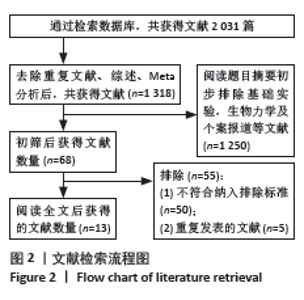
2.1 文献检索结果 通过上述检索方案,共获得2 031篇文献,中国知网数据库369篇,万方数据库284篇,维普数据库188篇,PubMed数据库297篇,Cochrane Library数据库46篇,Web of Science数据库317篇,Embase数据库530篇,排除重复文献、综述和Meta分析 713篇,通过阅读题目和摘要初筛得到68篇,最后全文阅读剔除不符合标准的文献,最终获得13篇符合纳入排除标准的文献[7,10-21],其中11篇回顾性队列研究[7,10-17,19,21],2篇随机对照试验[18,20],共1 136例患者,其中ROI-C组569例,融合器联合钉板组567例,见图2。"
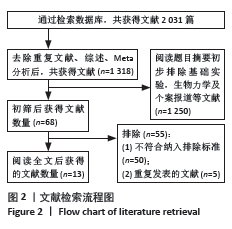
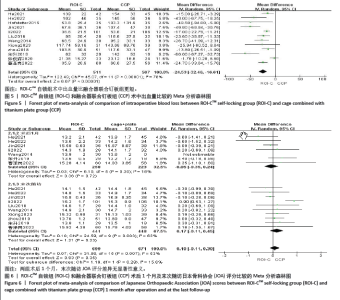
2.4 Meta分析结果 2.4.1 各组手术时间差异 共12篇文献对比了手术时间[7,10-17,19-21],有5篇文献按节段分亚组比较了手术时间[13-15,17,19],其中4篇文献涉及2个手术时间组[13-15,19],1篇文献涉及3个手术时间组[17]。亚组分析的数据在http://statstodo.com/CombineMeansSDs.php网站上将每个亚组的均值和标准差进行合并,使用合并后的均值和标准差进行数据分析[22]。 HOFSTETTER等[12]的数据采用的是mean±SEM,在RevMan软件中将数据转换为mean±SD后,进行数据分析。采用固定效应模型(P=0.15,I2=30%)。结果显示:两组手术时间差异有显著性意义(MD=-15.52,95%CI:-18.62至-12.42,P < 0.000 01),见图4。 2.4.2 各组术中出血量差异 共12篇文献对比了术中出血量[7,10-17,19-21],有5篇文献按节段分亚组比较了手术出血量[13-15,17,19],其中4篇文献涉及2个术中出血量组[13-15,19],1篇文献涉及3个术中出血量组[17]。同样在http://statstodo.com/CombineMeansSDs.php网站上将亚组分析的均值和标准差进行合并,在RevMan软件中将HOFSTETTER等[12]的数据转换为Mean±SD后,再进行数据合并。各研究之间存在异质性(P < 0.000 01,I2=76%),采用随机效应模型。结果显示:两组术中出血量差异有显著性意义(MD=-24.53,95%CI:-32.46至-16.61,P < 0.000 01),见图5。 2.4.3 各组术前与术后JOA评分差异 共8篇文献对比了术前JOA评分[7,10-11,13,15,17,19-20],采用固定效应模型进行分析(P=0.40,I2=4%),结果显示:两组术前JOA评分无显著性差异(MD=-0.01,95%CI:-0.22-0.21,P=0.96)。7篇文献对比两者术后1个月JOA评分[7,10-11,13,15,19-20],10篇文献对比两者末次随访JOA评分[7,10-11,13-17,19,20],各统计组之间具有统计学异质性(P=0.003,I2=63%),采用随机效应模型。结果显示,两组术后1个月JOA评分(MD=-0.05,95%CI:-0.35-0.24,P=0.72)与末次JOA评分(MD=0.17,95%CI:-0.11-0.45,P=0.23)均无显著性差异,见图6。 2.4.4 各组术前与术后颈椎功能障碍指数差异 共8篇文献对比两组术前颈椎功能障碍指数[7,10,11,13-15,17,19], 各研究之间存在异质性(P=0.14,I2=36%),采用固定效应模型,合并结果显示:两组术前颈椎功能障碍指数无显著性差异(MD=0.27,95%CI:-0.44-0.98,P=0.46)。共有5篇文献对比了两组术后1个月颈椎功能障碍指数[7,10-11,13,15],8篇文献对比了两组末次随访颈椎功能障碍指数[7,10-11,13-15,17,19],采用随机效应模型(P=0.06,I2=41%),结果显示:两组术后1个月颈椎功能障碍指数评分 (MD=0.23,95%CI:-0.72-1.17,P=0.64)与末次随访颈椎功能障碍指数评分指数评分 (MD=0.16,95%CI:-0.57-0.89,P=0.66,均无显著性差异,见图7。"
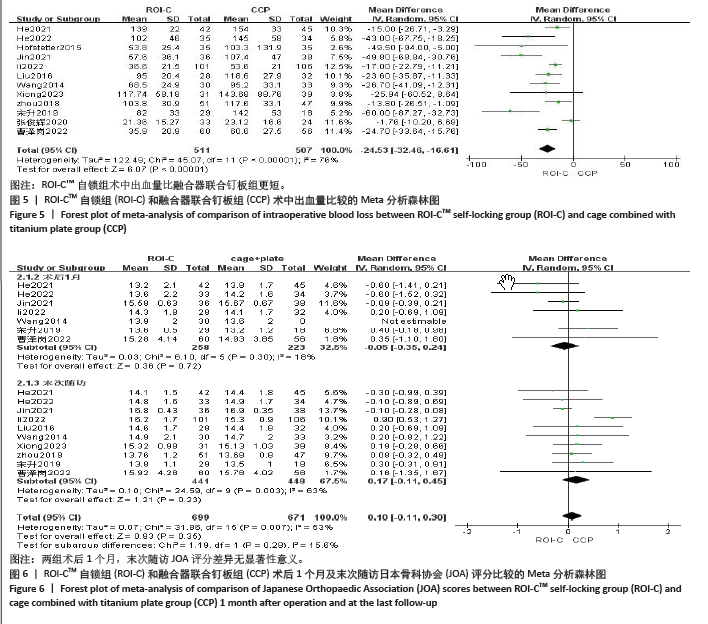
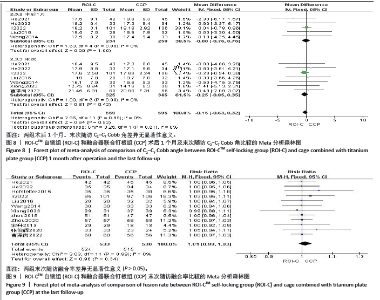
2.4.5 各组术前与术后C2-C7 Cobb角差异 术前有7篇文献对比了C2-C7 Cobb角[10,11,13-16,19],采用固定效应模型(P=1.00,I2=0%),合并结果显示两组术前C2-C7 Cobb角无显著性差异 (MD=0.60,95%CI:-0.19-1.39,P=0.13)。5篇文献对比了两组术后1个月C2-C7 Cobb角[10-11,13-15],7篇文献对比了两组末次随访C2-C7 Cobb角[10-11,13-16,19],采用固定效应模型(P=0.99,I2=0%)。结果显示:两组术后C2-C7 Cobb 角(MD =-0.00,95%CI: -0.76-0.76,P=1.00)末次随访C2-C7 Cobb角(MD =-0.25,95%CI:-0.85-0.35,P=0.42)均无显著性差异,见图8。 2.4.6 各组末次随访融合率差异 共12篇文献比较了两组末次随访融合率[10-21],采用固定效应模型(P=0.99,I2=0%)。结果显示:两组末次随访融合率无显著性差异(RR=1.01,95%CI:0.99-1.03,P=0.34),见图9。 2.4.7 各组邻近节段退变发生率差异 共9篇文献对比了两组邻近节段退变情况[7,12-19],采用固定效应模型(P=0.49,I2=0%)。结果显示:两组邻近节段退变发生率差异有显著性意义(RR=0.40,95%CI:0.27-0.60,P < 0.000 01),见图10。 2.4.8 各组术后融合器沉降率差异 共7篇文献对比了两组术后融合器沉降情况[7,10,13,16-19],异质性较高(P=0.08,I2=49%),采用随机效应模型分析。结果显示:两组术后融合器沉降率无显著性差异(RR=1.63,95%CI:0.99-2.66,P=0.05),见图11。"
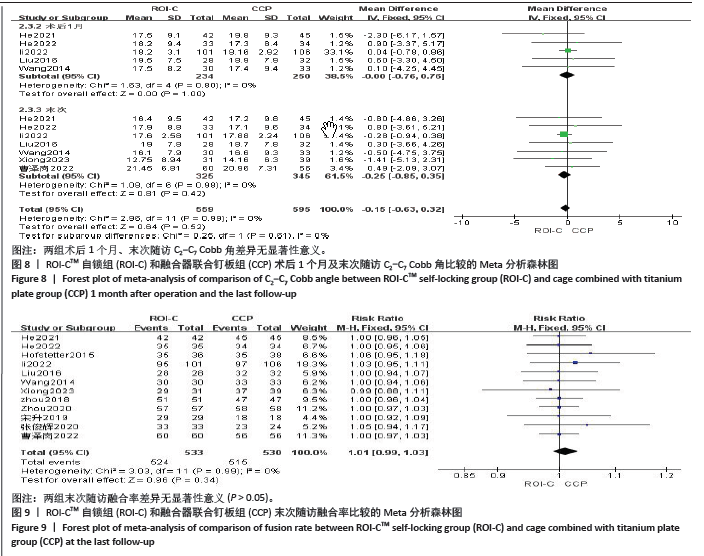
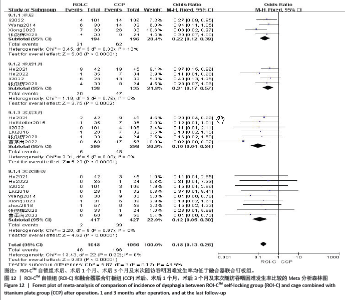
2.4.9 各组术后吞咽困难发生情况 共4篇文献对比了两组术后吞咽困难发生情况[13,15-16,21],4篇文献对比了两组术后1个月吞咽困难发生情况[10-11,13,21],6篇文献对比了两组术后3个月吞咽困难发生情况[10,12-14,19,21],9篇文献对比了两组术后末次随访吞咽困难发生情况[10,11,13-17,19,21],采用固定效应模型进行分析(P=0.92,I2=0%)。结果显示:两组术后(RR=0.22,95%CI:0.12-0.39,P < 0.000 01)、术后1个月(RR=0.31,95%CI:0.17-0.57,P =0.000 2)、3个月(RR =0.10,95%CI:0.04-0.24,P < 0.000 01)、末次随访(RR=0.12,95%CI:0.05-0.30,P < 0.000 01)吞咽困难发生率差异均有显著性意义,总的吞咽困难发生率也有显著性意义(OR=0.18,95%CI:0.13-0.26,P < 0.000 01),见图12。 2.5 亚组分析结果 2.5.1 手术时间 按手术节段将手术时间分为单节段、双节段和多节段3个亚组进行分析。共有5篇文献记录了单节段的手术时间[10,13,15,17,19],有6篇文献记录了双节段的手术时间[10,13,15,17,19,21],2篇文献记录了多节段的手术时间[14,17],其中LIU等[14]分别记录了3节段和4节段的手术时间,一并纳入多节段组。异质性较高(P < 0.000 01,I2=92%),采用随机效应模型。结果显示:两组在单节段(MD=-14.32,95%CI:-18.88至-9.76,P < 0.000 01)、双节段(MD=-14.05,95%CI:-15.01至-13.09,P < 0.000 01)、多节段(MD=-23.76,95%CI:-29.67至-17.85,P < 0.000 01) 手术时间差异均有显著性意义,所有数据合并后两组手术时间差异也具有显著性意义(MD=-17.82,95%CI:-21.77至-13.86,P < 0.000 01)。3个亚组之间差异有显著性意义(P=0.006,I2=80.2%),见图13。 2.5.2 术中出血量 按手术节段将其分为单节段、双节段和多节段进行亚组分析。共有5篇文献记录了单节段的术中出血量[10,13,15,17,19],有6篇文献记录了双节段的术中出血量[10,13,15,17,19,21],2篇文献记录了多节段的术中出血量[14,17],同样将LIU等[14]的数据一并纳入多节段组,采用随机效应模型(P=0.09,I2=54%)。结果显示:两组术中出血量在单节段(MD=-17.17,95%CI:-20.98至-13.35,P < 0.000 01)、双节段(MD=-18.48,95%CI:-27.97至-8.99,P=0.000 1)、多节段(MD=-17.04,95%CI:-23.58至-10.51,P < 0.000 01)均有显著性意义,所有数据合并后两组术中出血量差异也具有显著性意义(MD=-17.39,95%CI:-21.13至-13.66,P < 0.000 01)。3个亚组之间不存在统计学上的差异(P=0.97,I2=0%),见图14。 2.6 敏感性分析结果 将ZHOU等[18]和宋升等[20]的随机对照研究剔除后重新合并分析,发现在手术时间、术中出血量、融合率和术后邻近椎体退变异质性较前无明显改变,同时两组比较结果与之前一致,提示Meta分析结果可靠。 对术后JOA评分和颈椎功能障碍指数进行敏感性分析,发现LI等[13]的研究可能为异质性来源,剔除该项研究后重新进行合并分析发现异质性明显减少(I2=0%),采用固定效应模型分析,结果表明两组患者术后JOA评分和颈椎功能障碍指数仍无显著性差异(P > 0.05),提示Meta分析结果相对可靠。 对术中出血量和手术时间进行逐一剔除研究后重新合并分析,发现异质性较前无明显变化,未找到明显异质性来源。考虑到术中出血量和手术时间与术者经验、习惯和熟练程度及手术节段等高度相关,从而导致研究间异质性较大。 对于术后融合器沉降进行逐一剔除研究后重新合并分析,发现Meta分析结果随之发生改变,提示Meta分析结果稳定性较差。考虑术后融合器沉降与术者的操作及骨密度等多种因素相关,可能是导致结果稳定性较差的原因,因该研究纳入的文献较少,关于两者术后融合器沉降率的高低,未来仍需进一步的研究。 "
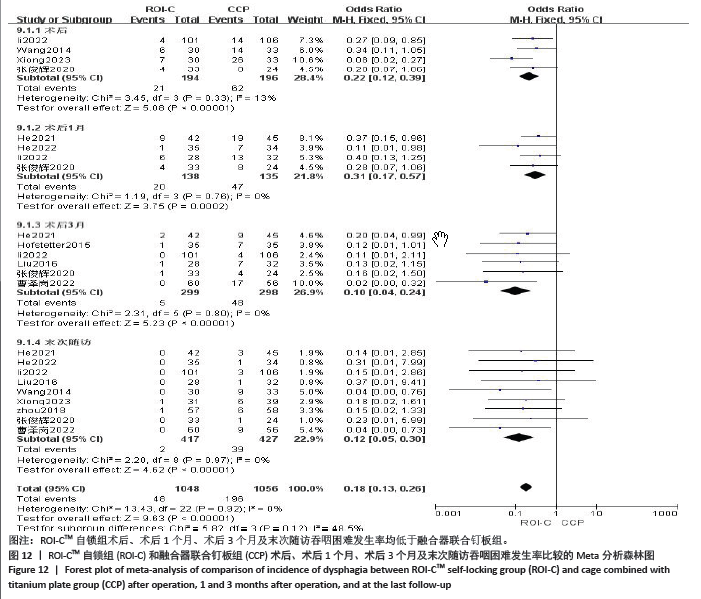
| [1] BOER LFR, ZORZETTO E, YEH F, et al. Degenerative cervical disorder-stand-alone cage versus cage and cervical plate: a systematic review. Global. Spine J. 2021; 11(2):249-255. [2] OLIVER JD, GONCALVES S, KEREZOUDIS P, et al. Comparison of outcomes for anterior cervical discectomy and fusion with and without anterior plate fixation: a systematic review and meta-analysis. Spine. 2018;43(7):E413-E422. [3] EPSTEIN NE. A Review of complication rates for anterior cervical diskectomy and fusion (ACDF). Surg Neurol Int. 2019;10:100. [4] 宋燕美,赵改平,李鹏祥,等. ROI-C椎间融合器植入对颈椎生物力学的影响[J].医用生物力学,2018,33(2):114-120. [5] BUCCI MN, OH D, COWAN RS, et al. The ROI-C zero-profile anchored spacer for anterior cervical discectomy and fusion: biomechanical profile and clinical outcomes. Med Devices. 2017;10:61-69. [6] IAMPREECHAKUL P, CHOOCHAIMANGKHALA P, TIRAKOTAI W, et al. Zero-profile anchored spacer (ROI-C) in the treatment of cervical adjacent segment disease. Asian J Neurosurg. 2022;17(2): 209-217. [7] JIN ZY, TENG Y, WANG H Z, et al. Comparative analysis of cage subsidence in anterior cervical decompression and fusion: zero profile anchored spacer (ROI-C) vs. conventional cage and plate construct. Front. Surg. 2021;8:736680. [8] XU J, HE Y, LI Y, et al. Incidence of subsidence of seven intervertebral devices in anterior cervical discectomy and fusion: a network meta-analysis. World Neurosurg. 2020;141:479-489.e4. [9] GUO Z, WU X, YANG S, et al. Anterior cervical discectomy and fusion using zero-p system for treatment of cervical spondylosis: a meta-analysis. Pain Res Manag. 2021;2021:3960553. [10] HE S, ZHOU Z, LV N, et al. Comparison of clinical outcomes following anterior cervical discectomy and fusion with zero-profile anchored spacer-ROI-C-fixation and combined intervertebral cage and anterior cervical discectomy and fusion: a retrospective study from a single center. Med Sci Monit. 2021;27:e931050. [11] HE S, ZHOU Z, SHAO X, et al. Comparing the bridge-type zero-profile anchored spacer (ROI-C) interbody fusion cage system and anterior cervical discectomy and fusion (ACDF) with plating and cage system in cervical spondylotic myelopathy. Orthop Surg. 2022;14(6):1100-1108. [12] HOFSTETTER CP, KESAVABHOTLA K, BOOCKVAR JA. Zero-profile anchored spacer reduces rate of dysphagia compared with ACDF with anterior plating. J Spinal Disord Tech. 2015;28(5): E284-E290. [13] LI P, LEI R, GAN L, et al. Comparing clinical and radiographic outcomes between the self-locking stand-alone cage and conventional cage-plate construct: a five-year retrospective cohort study. Spine (Phila Pa 1976). 2023;48(1):56-66. [14] LIU Y, WANG H, LI X, et al. Comparison of a zero-profile anchored spacer (ROI-C) and the polyetheretherketone (PEEK) cages with an anterior plate in anterior cervical discectomy and fusion for multilevel cervical spondylotic myelopathy. Eur Spine J. 2016;25(6):1881-1890. [15] WANG Z, JIANG W, LI X, et al. The application of zero-profile anchored spacer in anterior cervical discectomy and fusion. Eur Spine J. 2015;24(1):148-154. [16] XIONG X, LIU JM, CHEN WW, et al. Outcomes of different zero-profile spacers in the treatment of two-level cervical degenerative disk disease. Eur Spine J. 2023;32(7):2448-2458. [17] ZHOU J, LI J, LIN H, et al. A comparison of a self-locking stand-alone cage and anterior cervical plate for ACDF: minimum 3-year assessment of radiographic and clinical outcomes. Clin Neurol Neurosurg. 2018;170:73-78. [18] ZHOU J, LI J, LIN H, et al. Could self-locking stand-alone cage reduce adjacent-level ossification development after aneterior cervical discectomy and fusion? J Clin Neurosci. 2020;78:60-66. [19] 曹泽岗,夏刚,万军,等.颈椎前路椎间盘切除椎间融合术:零切迹自锁式椎间融合系统与传统融合器联合钛板内固定对比分析[J].中国现代神经疾病杂志, 2022,22(8):687-695. [20] 宋升,孙振中,姜为民,等.ROI-C与传统融合器联合钛板内固定治疗颈椎病:颈椎稳定性重建及椎间融合的比较[J].中国组织工程研究,2019,23(28): 4474-4478. [21] 张俊辉,许华亮,昌宏,等.颈前路零切迹融合器ROI-C与前路钛板内固定治疗双节段脊髓型颈椎病的比较[J].中国组织工程研究,2020,24(21):3329-3335. [22] SUN Z, LIU Z, HU W, et al. Zero-profile versus cage and plate in anterior cervical discectomy and fusion with a minimum 2 years of follow-up: a meta-analysis. World Neurosurg. 2018;120:e551-e561. [23] 李秋园,孙中仪,田纪伟.颈前路减压融合两种内固定的进展[J].中国矫形外科杂志,2022,30(3):244-247. [24] WANG Z, ZHU X, WANG Z, et al. Zero-P and ROI-C implants versus traditional titanium plate with cage to treat cervical spondylotic myelopathy: clinical and radiological results with 5 years of follow-up. BMC Musculoskeletal Disorders. 2023;24(1):539. [25] TSALIMAS G, EVANGELOPOULOS DS, BENETOS IS, et al. Dysphagia as a postoperative complication of anterior cervical discectomy and fusion. Cureus. 2022;14(7):e26888. [26] ALDAHAMSHEH O, ALHAMMOUD A, HALAYQEH S, et al. Stand-alone anchored spacer vs anterior plate construct in the management of adjacent segment disease after anterior cervical discectomy and fusion: a systematic review and meta-analysis of comparative studies. Global Spine J. 2023. doi: 10.1177/21925682231201787. [27] MAZMUDAR A, PAZIUK T, TRAN KS, et al. Evaluating dysphagia duration and severity after acdf in patients with underlying dysphagia - a prospective, multicenter study. Global Spine J. 2023. doi: 10.1177/21925682231201249. [28] NIU J, SONG D, LIU Y, et al. Revision surgery for symptomatic adjacent segment disc degeneration after initial anterior cervical fusion: is roi-c better than plate-cage construct? Biomed Res Int. 2021; 2021:6597754. [29] LU Y, BAO W, WANG Z, et al. Comparison of the clinical effects of zero-profile anchored spacer (ROI-C) and conventional cage-plate construct for the treatment of noncontiguous bilevel of cervical degenerative disc disease (CDDD): a minimum 2-year follow-up. Medicine. 2018;97(5):e9808. [30] ZHANG Z, LI Y, JIANG W. A comparison of zero-profile anchored spacer (ROI-C) and plate fixation in 2-level noncontiguous anterior cervical discectomy and fusion- a retrospective study. BMC Musculoskeletal Disorders. 2018;19(1):119. [31] RYU HS, HAN MS, LEE SS, et al. Influence of subsidence after stand-alone anterior cervical discectomy and fusion in patients with degenerative cervical disease: a long-term follow-up study. Medicine. 2022;101(38):e30673. |
| [1] | Zhang Xinxin, Gao Ke, Xie Shidong, Tuo Haowen, Jing Feiyue, Liu Weiguo. Network meta-analysis of non-surgical treatments for foot and ankle ability and dynamic balance in patients with chronic ankle instability [J]. Chinese Journal of Tissue Engineering Research, 2025, 29(9): 1931-1944. |
| [2] | Sun Yundi, Cheng Lulu, Wan Haili, Chang Ying, Xiong Wenjuan, Xia Yuan. Effect of neuromuscular exercise for knee osteoarthritis pain and function: a meta-analysis [J]. Chinese Journal of Tissue Engineering Research, 2025, 29(9): 1945-1952. |
| [3] | Wang Yida, Liu Jun, Wang Xiaoling, Wang Liyan, Yang Chengru, Zhang Xuexiao. Effects of wearable electronic device-based interventions on physical activity and sedentary behavior in healthy adolescents: a meta-analysis [J]. Chinese Journal of Tissue Engineering Research, 2025, 29(8): 1693-1704. |
| [4] | Zhang Zixian, Xu Youliang, Wu Shaokui, Wang Xiangying. Effects of blood flow restriction training combined with resistance training on muscle indicators in college athletes: a meta-analysis [J]. Chinese Journal of Tissue Engineering Research, 2025, 29(8): 1705-1713. |
| [5] | Wang Juan, Wang Guanglan, Zuo Huiwu. Efficacy of exercise therapy in the treatment of anterior cruciate ligament reconstruction patients: #br# a network meta-analysis #br# [J]. Chinese Journal of Tissue Engineering Research, 2025, 29(8): 1714-1726. |
| [6] | Zheng Huakun, Yin Mingyue, Liu Qian. Effects of interval and continuous training on the quality of life in physically inactive adults: a meta-analysis [J]. Chinese Journal of Tissue Engineering Research, 2025, 29(8): 1727-1740. |
| [7] | Li Zhe, Li Ping, Zhang Chao, Guo Guangling. A network meta-analysis of efficacy of mesenchymal stem cells from different sources in treatment of premature ovarian failure animal models [J]. Chinese Journal of Tissue Engineering Research, 2025, 29(36): 7898-7908. |
| [8] | Wang Feng, Cao Chunfeng, He Chao, Zhang Tao, Zhou Zixian, Zhu Fengchen. All-inside versus traditional techniques of anterior cruciate ligament reconstruction: meta-analysis of therapeutic efficacy and radiological outcomes [J]. Chinese Journal of Tissue Engineering Research, 2025, 29(35): 7629-7638. |
| [9] | Tian Jinxin, Zhao Yuxin, Hu Tong, Cui Tiantian, Ma Lihong. Effects of different transcranial magnetic stimulation modes on refractory depression in adults: a network meta-analysis [J]. Chinese Journal of Tissue Engineering Research, 2025, 29(35): 7639-7648. |
| [10] | Wang Kaigang, Hao Dongsheng, Ma Pei, Zhou Shuo, Li Ruimin. Comparison of efficacy of different biological scaffolds for pulp regeneration therapy in immature permanent teeth: a Bayesian network meta-analysis [J]. Chinese Journal of Tissue Engineering Research, 2025, 29(34): 7447-7460. |
| [11] | Yao Tingfeng, Liu Lin, Liu Shixuan, Lu Xinyue. Meta-analysis of the effectiveness of dry needling at myofascial trigger points in the treatment of knee disorders [J]. Chinese Journal of Tissue Engineering Research, 2025, 29(32): 6989-6996. |
| [12] | Wang He, Yu Shaohong, . Meta-analysis of transcranial direct current stimulation in improving lower limb motor dysfunction in stroke patients [J]. Chinese Journal of Tissue Engineering Research, 2025, 29(30): 6556-6565. |
| [13] | Liang Jiyao, Zhou Honghai, Wei Guikang, Su Shaoting, Chen Longhao, He Xinyu, Liu Liangpu. Quantification of in vivo biomechanics and analysis of influencing factors in cervical spine fixed-point rotation manipulation [J]. Chinese Journal of Tissue Engineering Research, 2025, 29(3): 486-492. |
| [14] | Wang Jianlei, He Peiliang, Sun Yongjian. A meta-analysis of clinical efficacy and safety of intravenous glucocorticoids before lower limb joint arthroplasty [J]. Chinese Journal of Tissue Engineering Research, 2025, 29(3): 599-607. |
| [15] | Li Jia, Liu Qianru, Xing Mengnan, Chen Bo, Jiao Wei, Meng Zhaoxiang. A network meta-analysis on therapeutic effect of different types of exercise on knee osteoarthritis patients [J]. Chinese Journal of Tissue Engineering Research, 2025, 29(3): 609-616. |
| Viewed | ||||||
|
Full text |
|
|||||
|
Abstract |
|
|||||
